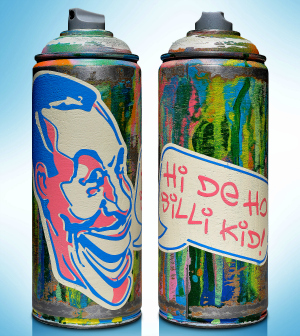
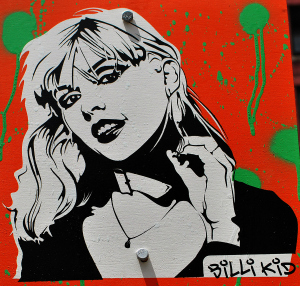
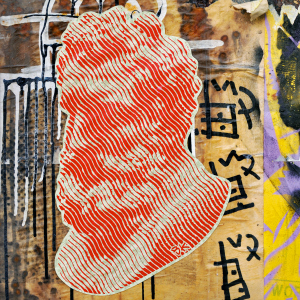
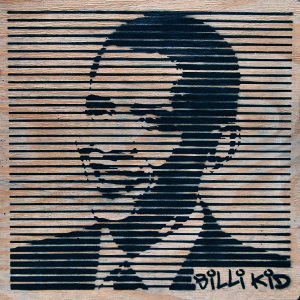
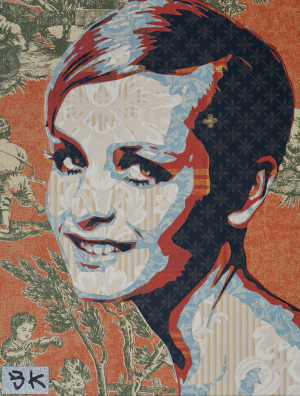
Well known for his massive Sticker Combo Slap operations, BILLIKID is also a very inventive stencil artist who never stops challenging the limits of this primal street art form. For BILLIKID, it is all about using stencils as a social medium ahead of social media, building both a strong personal brand and a very captive audience at once. Constant oscillations between exterior (street) and interior (studio) surfaces set smart and fast BILLIKID free from the many restrictions and obligations imposed by the Fine Art system … Instead, joyful visibility, experimental movement and pragmatic scalability are his key revendications ! We managed to immobilize hyperactive BILLIKID under the Grand Central Park Avenue viaduct in NYC for a short moment and had him reminisce about his early stencil days :
PLIPP : How did street art start for you ?
BILLIKID : As growing up, I always wanted to be an artist, a fine artist, but practicality led me to being a commercial artist. I have come from extremely humble beginnings … My parents were divorced and my mother came to this country from Columbia. She was a maid. I had an opportunity through a scholarship to go to art school. I wanted to be a fine artist but the scholarship dictated that I should take a more conventionnal approach … How foolish would it be for me to spoil an opportunity to go to school for free ! So commercial art was my vehicle in order to make a career. I worked in advertising all my life. I had a great career. I worked for some fabulous agencies. BILLIKID was born from a book. It is about ten years old now. The book is The Long Tail by former Wired editor CHRIS ANDERSON. I read this book and it chronicles how musicians took control of their art. Napster was happening, the Internet was blossoming, there was no social media yet, no crowdfunding but what the book did is it showed a path of how to find the middle ground … It is not about making a million dollars or flipping burgers … It is about creating your art and making a living at it. The book centers around audio artists but when I read it, I thought : what about a visual artist ? So I said, well, how do I create my own path to become a fine artist ? I was already a successful commercial artist so street art became the next vehicle. The lightbulb went off ! There is an audience, there is documentation because people document the work that goes up and people can react to your work. The street art allowed me to have this audience and if you are more provocative, then you can have an active audience, especially online. I come from a branding world and I know that the first thing I needed was that the audience knows who created that piece of art. So BILLIKID was a conscious, deliberate method. This book just awoke my passion to be who I am, a creative. Then, the evolution of the BILLIKID brand has taken me from trying to grow as a fine artist to this world where brands actually pay attention and I can work with them.
PLIPP : Why did you choose stencils ?
BILLIKID : Stencils became my handwork. Stencils happen to be my medium in order to express my art but my primary expression is content. Stencils became the craft of my work because I am intimidated by the freedom of just getting a brush and going crazy. I am too formatted … The stencil allows me to be precise and everything. The cut and the delivery, it is all about control. I hope one day I can just let my soul be free but I am such a control freak in the way I approach everything that stencils allow me to be able to deliver a portrait that resembles you or whoever I am going after.The stencils allow me to control the process. And what I first did was that I went out on the streets. I looked at what was happening. A lot of it was black and white. A lot of it was dark and so, I deliberately wanted to create a more positive kind of character … BILLIKID is about colors, kids, happiness … I wanted to do the opposite of that and in the beginning it was fantastic because there was a lot of reaction. Just by the sheer opposition of what was already on the street. It was about going against skulls, bones, gas masks … I am a positive person and my personality has to be part of it. I wanted my art to reflect this sort of colorful attitude. At the same time, I had access to all this equipment. I had printers, colors, all these things which generally an urban artist doesn’t have access to. I was able to create large posters, to create a vibe. It is all about recreation and stencils allow you to recreate. I needed to find a method to duplicate the same image over and over again to put up so stencils just imitate the idea. It is another method of printing. The spray can is the brush of graffiti so here the stencil allows me to be duplicative and use the brush that is part of the genre. I remember my very first stencil was of CAB CALLOWAY with a talk bubble that read : Hi De HO BIILI KID! I painted him on wood rectangles and on empty spray cans. The wood pieces I posted on stop signs all over Manhattan. It was a great pleasure leaving behind a little piece of myself that others can take home if so desired … Needless to say I was hooked on stencils thereafter and committed myself to the process and the development of a personal style.
PLIPP : How is all this evolving right now ?
BILLIKID : When it comes to fine art, it is got to be hand cut and hand painted. Absolutely. But the stuff I put on the street, I don’t know if it is going to last a day or ten days so I don’t want to spend that much time on it. I no longer want to cut a stencil the way somebody would hand cut their stencils. I like to paint in the privacy of my studio and place on the streets therafter. Stencils, like posters and stickers, allow for replication. Duplicity itself is a form of expression. So I want to do it like nobody could ever cut a stencil like this by hand. I always want to use a technology to its full potential. One of the things I wanted to do was figure out a way to push the technology. The way I do my stencils now is like transfers. I don’t have to build bridges. It is a one-time use. I achieve two goals, my stencils have some unique look and they are disposable. They are not reusable. As a creative director, you always want to find how to get from point A to point B in the shortest time possible. So my willingness to push the technology is a deliberate attempt. Because I am ADD, once I have an idea for a piece of art, I just want to execute it as fast as possible. I want to figure out how to make it look beautiful but as fast as possible. The process to me is not as important as the concept but, of course, you don’t want to have something that nobody likes so there is got to be that balance of how to get from point A to point B fast but also deliver on your concept ! You have to make sure your concept is perceived properly and that it is executed in a beautiful manner. It is just a way to move on and evolve the technique, like taking it to a different level. I am experimenting with reverse stencils, for instance. I am using four layers and I have been doing some images with vintage wallpaper. It is the same stencil technique but rather than spray a negative, I am cutting out a positive and the stacking it on top and wheat pasting on top so I am building the layers but with vintage wallpaper. It is really beautiful ! You know, I get bored easily and need to keep mixing things up … I am not trying to impres anyone with my craft. I am just happy sharing my ideas.
PLIPP : Do you have a message to the world ?
BILLIKID : Do what you love and be passionate about it !
Facebook : Billi Kid
Instagram : billikidbrand
Website : Billikid.com
Credits : All the illustrations have been provided by BILLIKID.
Note : Big thanks to ERIC MARECHAL from the THE ART FABRIC for pointing the author towards BILLIKID.
Note : The interview took place around beers and wines at the Pershing Square Cafe in NEW YORK CITY.
Note : Additional excerpts from the interview of BILLIKID will be published in a new book due to be released by BRIGADIER PLIPP end of 2018.
Copyright BRIGADIER PLIPP for MAEDIA Publishing for the text and the photos unless indicated otherwise.
